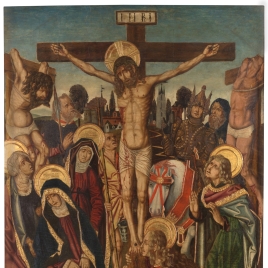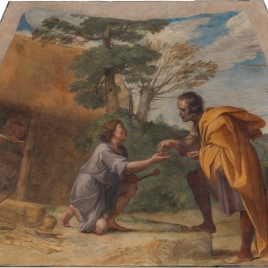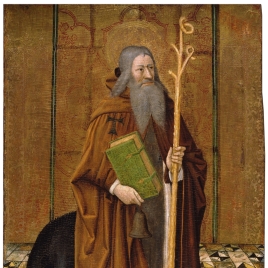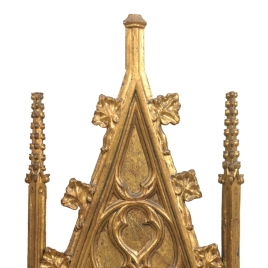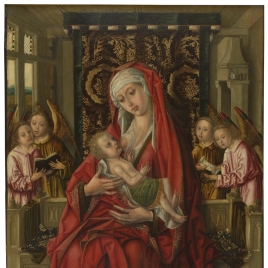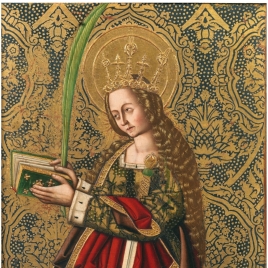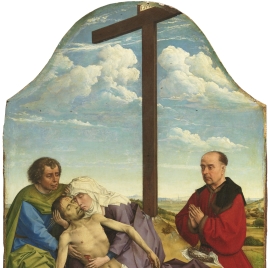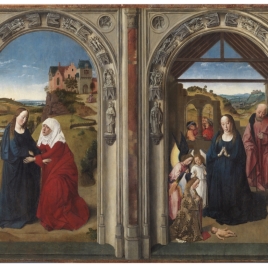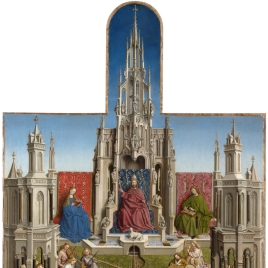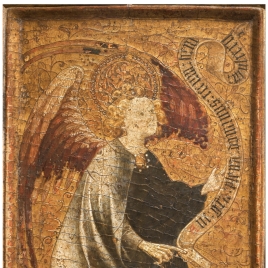Cargando ...
Explore the collection
Artist
Orpheus and Eurydice in the Underworld
Oil on canvas. 1652
This mythological scene is one of the three currently-known paintings by Pieter Fris. It depicts the moment when Orpheus, having descended into the realm of darkness to search for his wife Eurydice, killed by a snake bite, embraces her in the presence of Persephone and Hades, who has allowed him to rescue her from the Underworld and return her to life, provided he does not look back until he reach
Mixed method on panel. Ca. 1480
This is one of Bernat’s early works and is very similar to the work of Bermejo in the anatomy, colour and slim proportions of the figures in it -Saint John, the Magdalene, Longinus- as well as the little use of gold in the figures and in the scenery. The composition, a grandiose crucifixion which could have been completed in Bermejo’s workshop and with his help, is based on that of the altar piece
Oil on panel. Ca. 1525
This painter is one of the most outstanding and singular representatives of the early Renaissance in Palencia. While there are no extant documents to prove it, this work must somehow be connected with Juan de Flandes (doc. 1496-1519) during the time that he was working in Palencia (1509-1519). This is visible in the strong dependence of its figures on Flandes´s models, as well as the manner of dep
Saint Didacus of Alcalá receiving alms
Fresco painting on mural transferred to canvas. 1604 - 1605
Saint Didacus of Alcalá receiving alms
Fresco painting on mural transferred to canvas. 1604 - 1605
Carracci, Annibale ; Albani, Francesco
Annibale Carracci painted these works without previous cartoons as part of a group for the chapel of San Diego de Alcalá at the Church of San Giacomo degli Spagnoli in Rome. This church’s founder, don Diego de Herrera, commissioned Albani and Carracci to paint these works, for which the latter supplied all of the drawings. Badalocchio and Lanfranco were also involved. King Ferdinand VII had
Tempera on panel. 1450 - 1460
This must have been the central panel of an altarpiece dedicated to Saint Anthony Abbot. He is shown with his attribute of a pig. The flames at his feet allude to the illness known as "Saint Anthony´s fire". Reixach is a key figure in hipano-flemish painting in Valencia in the middle decades of the fifteenth century. He ran a large workshop.
The Arrival in England of Saint Ursula
Tempera on panel. 1425 - 1450
These works formed the upper section of the Altar Piece of Saint Ursula in the church of San Pablo in Palencia. The style of these paintings, typical of the International Gothic, led them to originally be considered Valencian. The painter follows the Golden Legend by Jacobus de Voragine (thirteenth century). Each story, translated into bright colours, abundant amounts of gold, and in different set
The Temptations of Saint Anthony Abbot
Oil on panel. 1543 - 1550
Saint Anthony is tempted by the Devil, transformed into a beautiful naked woman accompanied by a witch. The burning city in the background, the monsters and other elements are derived from Bosch (c. 1450-1516). However, the figures of Saint Anthony, the witch and particularly the female nude reveal Van Aelst’s assimilation of the new Italian Renaissance idiom.
Oil on panel. 1562 - 1567
The Birth of the Virgin at the Museo del Prado, the only painting on this subject by the hand of Luis de Morales and a work that remained unpublished until 2003, and the two pieces at the Museum Schloss Fasanerie in Eichenzell, The Presentation in the Temple and The Visitation, which are little known in Spain, belong in all probability, as Gabriele Finaldi pointed out, to one and the same set, a j
Conan’s baptism before Saint Ursula and her father
Tempera on panel. 1425 - 1450
This work, together with the three others (P007630, P007631, P007633), used to be part of the upper register of an altarpiece devoted to the legend of the Eleven Thousand Virgins in the church of San Pablo de los Dominicos in Palencia.This monastery suffered the consequences of the 1835 Ecclesiastical Confiscations that left it practically abandoned and subject to damage until it was returned to t
Mixed method on panel. Ca. 1490
The artist of this panel is traditionally referred to as the Master of the Luna Family, whom Post first identified in 1933 as one of the two painters who produced the altarpiece for the chapel of Saint James the Apostle in Toledo Cathedral, founded by Don Álvaro de Luna. It was the latter`s daughter, María de Luna, Duchess of El Infantado, who contracted the altarpiece on 21 December
Mixed method on panel. 1475 - 1485
This is the right panel of the Altar Piece of the Pietà, Saint Michael and Saint Catherine from the church of Santa María in Ejea de los Caballeros (Zaragoza). As is the norm in Ximénez’s figures, the Saint, shown with her usual attributes -crown, palm, book, sword and wheel- has less marked yet more expressive features than those of Bernat, an artist he sometimes worked with.
Oil on panel. 1440 - 1450
Weyden, Rogier van der (Workshop of)
The panel has been extended at the top: the original part is one board of Baltic oak, horizontal in grain and about 27 cm high. Sections of the unpainted edges survive on all four sides. The last ring in this original part of the panel was formed in 1418. Above is an addition, also of oak; it is cut into an arched shape fashionable in the late fifteenth and early sixteenth centuries. Dendrochronol
Tempera on panel transferred to canvas. 1450 - 1460
His hands bound and with a resigned expression, Christ advances towards the elegantly dressed Pilate, who is depicted with skin of a greyish tone. The exaggerated gestures of the heavily armed retinue around Christ function to emphasise the scene’s violence. This painting has recently been associated with an Ecce Homo in the Museo de Guadalajara. Both its provenance from La Alcarría and its
The Temptations of Saint Anthony
Oil on oak panel. 1550 - 1560
Bosch, Hieronymus (Follower of)
En un devastado paisaje rocoso, san Antonio aparece apoyado sobre una roca, con un libro entre las manos y rodeado de seres que son metáforas de toda suerte de males, pecados y vicios que acechan su virtuosa condición de ermitaño. Al fondo, la escena de batalla y la ciudad en llamas aluden al conflicto interior que sufre y al infierno al que le abocaría ceder a las tentaciones. Clave de esta lectu
Triptych of the Life of the Virgin
Oil on panel. Ca. 1445
This triptych presents four scenes: the Annunciation, the Visitation, the Adoration of the Angels and the Adoration of the Magi. Painted around 1445, it is considered the earliest surviving work by Dirk Bouts. Stylistically, it resembles his later paintings except for the canon of its figures, which are much shorter here than in posterior works. Besides the interest Bouts shows in landscape from t
Oil on panel. 1440 - 1450
Eyck, Jan van (Workshop of)
This painting is made in three planes. At the top, Christ on the throne between the Virgin and Saint John the Evangelist with the Lamb at his feet, from which a spring flows. In the middle plane are a heavenly choir with its musicians. On the left side of the bottom plane are kings, noblemen, popes and theologians, while the right side shows various confused, fleeing Jews, one of whom is blindfold
Tempera on panel. 1425 - 1450
The two panels (P2720 and P2721) formed an exquisite portable diptych dedicated to the moment when the Archangel Gabriel announces to Mary that she will conceive the Son of God. Despite paint losses, we can still appreciate the delicacy of the faces and the fluency of the evanescent, almost weightless figures represented against an abstract gold background with multiple sgraffiti of leaves and flo
Tempera on panel. 1425 - 1450
These panels (P2721-P2721) formed an exquisite portable diptych dedicated to the moment when the Archangel Gabriel announces to Mary that she will conceive the Son of God. Despite paint losses, we can still appreciate the delicacy of the faces and the fluency of the evanescent, almost weightless figures represented against an abstract gold background with multiple sgraffiti of leaves and flowers.
Loading...


